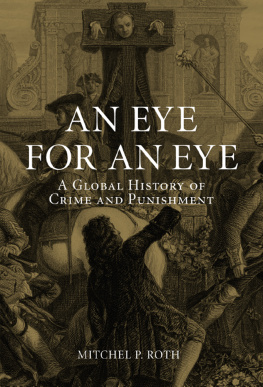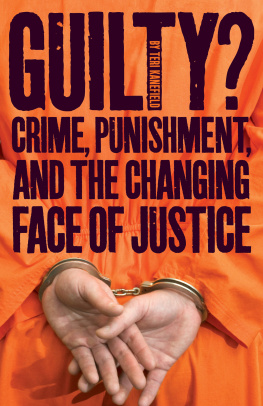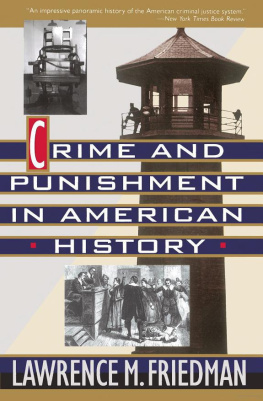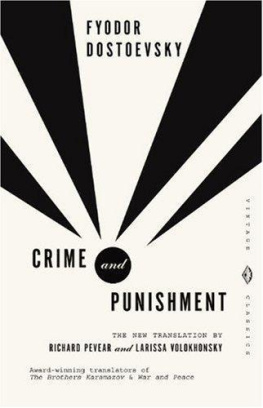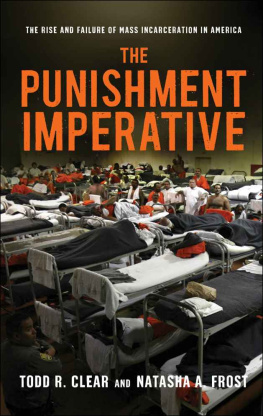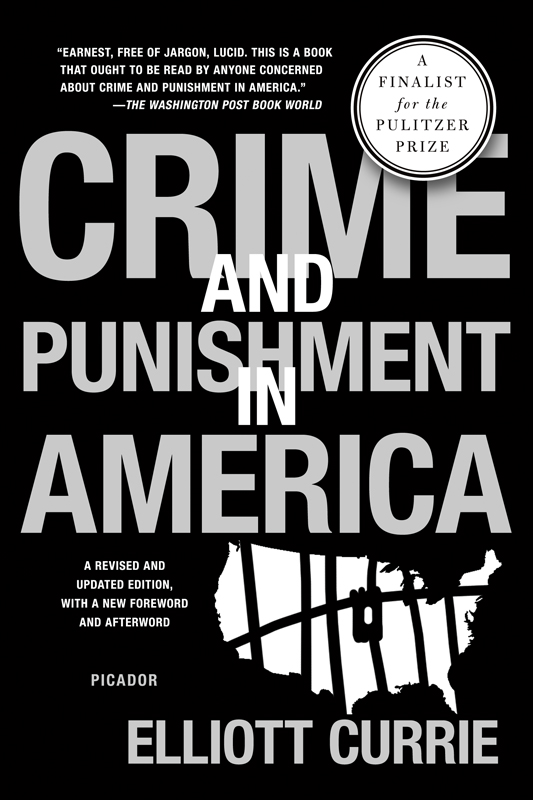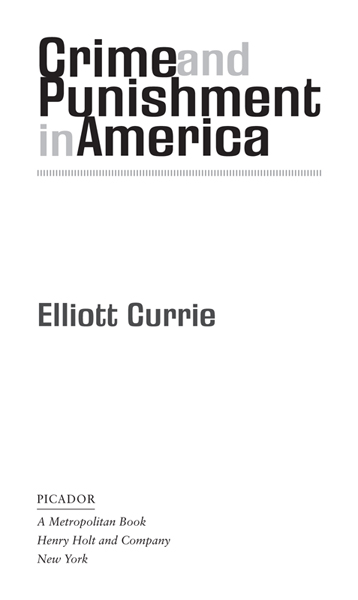
The author and publisher have provided this e-book to you for your personal use only. You may not make this e-book publicly available in any way. Copyright infringement is against the law. If you believe the copy of this e-book you are reading infringes on the authors copyright, please notify the publisher at: us.macmillanusa.com/piracy.
CONTENTS
ACKNOWLEDGMENTS
Special thanks to Sara Bershtel, Stephen Hubbell, and their colleagues at Metropolitan Books for their customary care and skill, and to John Brockman and Katinka Matson for their support. Many of the ideas in these pages first surfaced as the Thirtieth Anniversary Lecture sponsored by the National Association for the Care and Resettlement of Offenders (NACRO) in London in 1996, and Im most grateful to Helen Edwards and her staff for their hospitality. The same ideas appeared again later that year in a talk to the annual conference at the James A. Baker III Institute for Public Policy at Rice University: thanks especially to Lee Brown and Edward Djerejian for the opportunity to try them out. This book, like much of what Ive written, has also benefitted enormously from the help of Ron Watanabe and the staff of the Center for the Study of Law and Society at the University of California, Berkeley. None of these people, of course, bears responsibility for my conclusions. Nor do any of the friends and colleagues whose work and conversation have in one way or another enriched my own thinking. That list is becoming very long, but even its shortest version surely includes Brooke Bedrick, Frank Cullen, Lynn Curtis, Bob Dunn, David Fogarty, Terry Kandal, Dan Macallair, John, Luke, and Susannah Maddock, Sheldon Messinger, Vincent Schiraldi, Jerome Skolnick, Vivien Stern, Ian Taylor, David Wellman, Jock Young, and Franklin Zimring. Thanks to all, and to Rachael Peltz and Sonia Peltz-Currie for cheerfully tolerating the books intrusion into their lives.
PREFACE TO THE 2013 EDITION
In the summer of 2012, newspapers reported a grim new statistic: the number of American military personnel killed during the eleven years of the war in Afghanistan had reached 2,000. In the eleven years following the publication of the first edition of this book, more than 175,000 Americans died here at home from criminal violence. Thats not to minimize the tragedy of the many lives lost to violence in our war halfway around the world. But it reminds us that the much longer-running tragedy of violence on our streets and in our homes is still very much with us. Partly because that tragedy is mainly confined to less visible parts of our society, and partly because it is not as bad as it was twenty years ago, it has receded from national attention. I decided to revise this book, in part, to bring it back.
This updated edition of Crime and Punishment in America keeps the books original argument intact and adds an extensive afterword that brings the story up to the present. It updates the trends in incarceration and crime since the first edition appeared, reviews new evidence on the effects of our massive increase in imprisonment in the past several decades, and presents a great deal of new research on alternativesin policing, rehabilitation, and prevention programs. And it concludes with some thoughts about the challenges we face for the future.
I decided to keep the books original analysis intact because I think it still speaks cogently to the state of crime and justice in America. As Ill detail in the new afterword to this edition, there have been some significant changes in the years since this book first appeared. But there are more ways in which things are all too similar. The number of Americans behind bars, already at unprecedented levels when I wrote, grew by another 600,000 over the next decadebut at a slower pace than before, and it has now even declined slightly, for the first time in nearly forty years. Violent crime, which had been falling when the first edition was published, fell a little more and then stabilized as we entered the twenty-first centurydipping again in roughly the last two years. That plateau, as well see, masked a more complex and more troubling pattern in which serious crime decreased in some places and among some peoplebut held steady and even rose among others. The bottom line is that fifteen years after Crime and Punishment in America warned that our dominant strategies against crime werent working well, the United States is still distinguished by having both the worlds highest level of imprisonment and the advanced industrial worlds worst levels of serious criminal violence. And we are still, for the most part, relying all too heavily on an approach to crime control that is ineffective, costly, and destructive.
The book was written at a time when it was widely argued that we suffered the crime problem we did because we had been insufficiently tough on criminals. And we were reacting accordingly. We were putting more and more people behind bars who would not have gone there in the past, and putting them there for longer. We had, as a result, transformed our criminal justice systemnever exactly a model of humanity or efficiencybeyond recognition. In a deeper sense, we had chosen to use the prisons as our first line of defense against the consequences of deeply entrenched economic and racial inequalities and a legacy of neglectful and heedless social policy. I worried then that if we continued on that path we might create a society in which a permanent state of social disintegration is held in check only by the creation of a swollen apparatus of confinement and control that has no counterpart in our own history or in any other industrial democracy. We did, for the most part, continue on that path: and that is, to a troubling degree, precisely the kind of society we have become. We have become curiously complacent about this situation. But complacency is the enemy of good policy. And, as Ill argue in the afterword, it could get us into worse trouble in the future.
As in the 1990s, however, there is encouraging evidence that things need not be this way. The prisons are still swollen, but support for mass incarceration as a crime control strategy has eroded, both intellectually and politically, since Crime and Punishment in America was publishedand, again, the relentless increase in the national prison population has slowed and in some places reversed. And meanwhile, evidence that there are other and better ways of dealing with crime has continued to grow. This book argued, against what was then a powerful negative current in American thinking about social policy, that there were many promising alternatives to relying on the prisons to contain crime. We could use the justice system itself more intelligently by emphasizing prevention and rehabilitation over the blind resort to custody and intimidation: we could invest in programs for vulnerable children, youth, and families that could help to prevent crime from happening at all: and we could finally commit ourselves to tackling the deeper social deficits that, not coincidentally, also set the United States apart from other, less violent industrial societies. Today, as I will show, there is much more evidence in support of those alternatives: and though not every program I described in the first edition has stood up well under later assessment, many haveand newer and equally promising ones have emerged as well.
But the book also challenged the view that a little more investment in proactive policing or preschool for disadvantaged children would do the job by itself. Contrary to a chorus of naysayers in the 1980s and 1990s, there was much we could do to reduce American violence, and we knew a good deal about how to do it. We knew that, in part, because other countries had managed to keep their levels of violent crime and their levels of incarcerationlow. But we couldnt do it on the cheap, and we couldnt do it without being bold enough to engage in fundamental social change.


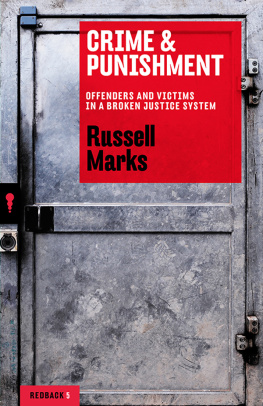
![Laura L. Finley - Crime and Punishment in America: An Encyclopedia of Trends and Controversies in the Justice System [2 Volumes]](/uploads/posts/book/305562/thumbs/laura-l-finley-crime-and-punishment-in-america.jpg)
